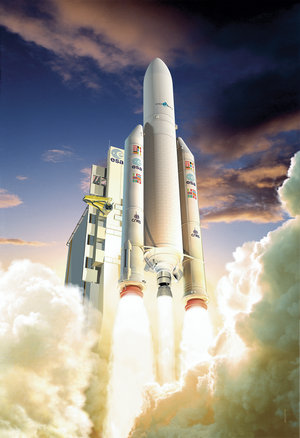Ariane 5 ECA
| Ariane 5 ECA | |
|---|---|
| Height | up to 53 m |
| Diameter | up to 5.4 m |
| Liftoff mass* | 780 t |
| Payload mass** | 10.0 t |
* Double launch
** Into geostationary transfer orbit (GTO)
A version of the Ariane 5 launcher, Ariane 5 ECA, was designed to place payloads weighing up to 9.6 tonnes into GTO. With its increased capacity, Ariane 5 ECA could handle dual launches of very large satellites.
This version of the Ariane 5 helped to maintain Europe’s competitiveness in the commercial space transport sector by offering customers the opportunity to launch a wider range of heavier satellites while reducing launcher production costs.
Ariane 5 ECA: new elements
Ariane 5 ECA was an improved Ariane 5 Generic launcher. Although it had the same general architecture, a number of major changes were made to the basic structure of the Ariane 5 Generic version to increase thrust and enable it to carry heavier payloads into orbit.
Solid boosters (EAP)
The EAP boosters’ upper segment of the Ariane 5 ECA (also known as segment S1) carried 10% (2.5 tonnes) more propellant. This extra propellant gave the Ariane 5 ECA an additional 50 tonnes of thrust in the first 20 seconds following liftoff. Together the twin boosters delivered a thrust of 1300 tonnes at liftoff, nearly 10 times the level delivered by the engine of the central stage.
The boosters were also equipped with a nozzle that had fewer parts and was easier and cheaper to produce.
Main stage (EPC and Vulcain 2 engine)

An improved version of the Vulcain engine was developed and used on the Ariane 5 ECA version. The Vulcain cryogenic engine was modified to increase its thrust by 20%, up to 137 tonnes. This Vulcain 2 operated under slightly higher pressure with a mixture ratio that had 20% more liquid oxygen than the Vulcain 1. Because of this change in the mixture, a new oxygen turbopump was developed.
In addition, the Vulcain 2 turbopump exhausts were reinjected into the main system, thus improving engine performance at high altitude. The Vulcain 2 engine was a key contributor to the additional lift capability of the new Ariane 5 ECA version into GTO.
To hold the extra liquid oxygen needed for the EPC core stage, the capacity of the liquid oxygen tank was increased by 16 tonnes. This was achieved by relocating the common tank bulkhead between the liquid oxygen tank and the liquid hydrogen tank of the Ariane 5 Generic EPC stage and reinforcing the structure elements.
The fuel load capacity of the EPC was:
- Liquid oxygen: 150 tonnes
- Liquid hydrogen: 25 tonnes
The EPC stage operated for nearly 540 seconds. It also performed the roll control function during all its propulsion phase. At shut down, at an altitude between 160 km and 210 km depending on the mission’s trajectory, the EPC stage separated from the upper composite and reentered the atmosphere above the Atlantic Ocean.















 Germany
Germany
 Austria
Austria
 Belgium
Belgium
 Denmark
Denmark
 Spain
Spain
 Estonia
Estonia
 Finland
Finland
 France
France
 Greece
Greece
 Hungary
Hungary
 Ireland
Ireland
 Italy
Italy
 Luxembourg
Luxembourg
 Norway
Norway
 The Netherlands
The Netherlands
 Poland
Poland
 Portugal
Portugal
 Czechia
Czechia
 Romania
Romania
 United Kingdom
United Kingdom
 Slovenia
Slovenia
 Sweden
Sweden
 Switzerland
Switzerland




























